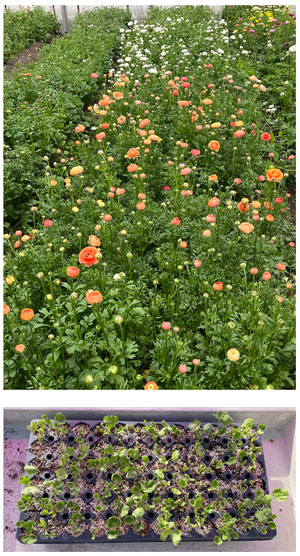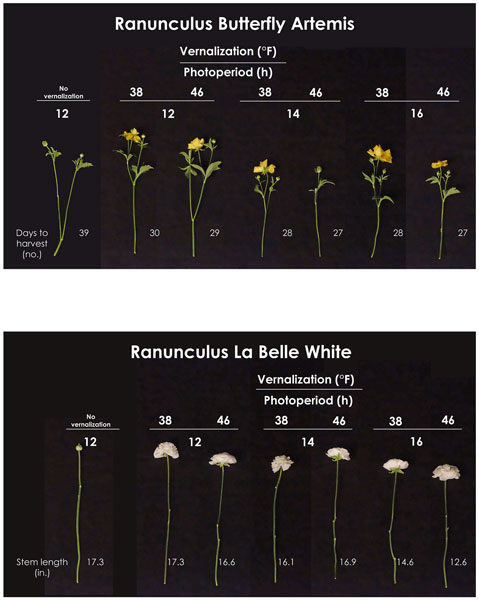3/1/2025
Reaping the Rewards of Ranunculus
Roberto Lopez & Jessie Brown

As the year-round demand for locally grown specialty cut flowers increases, growers are increasingly interested in producing cool-season cuts to diversify their spring product offering beyond tulips, daffodils and peonies. Crops that are commonly classified as cool-season crops include, but are not limited to: bachelors’ button (Centaurea cyanus), forget-me-not (Myosotis sylvatica), godetia (Clarkia amoena), Persian buttercup (Ranunculus asiaticus), poppy anemone (Anemone coronaria), pot marigold (Calendula amoena), stock (Matthiola incana) and sweet pea (Lathyrus odoratus).
In southern and some coastal regions of the U.S., these crops can be planted outdoors in the fall or in a high tunnel and will flower the following spring. In temperate regions such as the central and northern U.S., temperatures are too cold for fall planting and therefore cool-season crops must be planted in late spring. Unfortunately, this doesn’t give them enough time to grow before it gets too warm and results in reduced or poor-quality cuts. However, young plants or bulbs can be planted in high tunnels and greenhouses from early to late fall (i.e. succession planting) to flower from winter to early summer (Figure 1). This allows for multiple harvests throughout the late winter and early spring to target key market dates such as Valentine’s Day, Mother’s Day and Easter.
Figure 1. Forget Me Not Farms in Ottawa Lake, Michigan, produces ranunculus cut flowers in their greenhouse from the end of December to mid-May.
Figure 2. A 72-cell tray with pre-sprouted ranunculus tuberous roots.
Ranunculus, or Persian buttercup (Ranunculus asiaticus), are valued by consumers for their tight flower buds and cup-shaped flowers with delicate petals that resemble peonies. Growers, on the other hand, are attracted to the wholesale prices that range from $1.50 during the peak season to $4.00 per stem during the offseason. Given their intolerance to high temperatures, high tunnel (to a certain extent) and greenhouse production allow for greater control and manipulation of environmental parameters, which can ensure consistent production of high-quality cuts during the offseason. Unfortunately, growers have reported that succession planting doesn’t always result in consistent and uniform cut flower production and quality. This led us to look at the scientific literature to determine what triggers their flowering response.
We found inconsistent and contradictory reports indicating that the tuberous roots needed to be pre-sprouted and receive a cold treatment (vernalization). However, the recommended vernalization duration and temperatures were across the board, while other reports indicated that vernalization wasn’t required. Yet other publications indicated that photoperiod (daylength) influenced time to flower. Therefore, our objective in this study was to quantify the influence of different vernalization temperatures, durations and photoperiods on ranunculus flowering, cut flower yield and quality.
The study
We received 2- to 4-cm tuberous roots of Ranunculus Amandine Black, Butterfly Artemis and La Belle White. They were placed in mesh bags, submerged into aerated water that was kept at 68F (20C) and allowed to rehydrate for eight hours. Depending on size, the rehydrated tuberous roots were then transplanted into 18- or 72-cell trays filled with a commercial soilless substrate.
To promote root growth and shoot develop-ment, the trays were placed in a cooler for four weeks of “pre-sprouting” that consisted of a temperature setpoint of 42F (5.5C) and under LEDs providing a light intensity of 200 µmol·m–2·s–1 for 12 h (Figure 2). The trays were then moved to coolers with temperature setpoints of 38, 41 or 46F (3.5, 5 or 7.5C) for zero, two or three weeks of vernalization and under the same light intensity.
After their respective vernalization treatments, the sprouted tuberous roots were transplanted into bulb crates filled with a soilless substrate and spaced with 13-in. centers at a density of 26 plants per 10 sq. ft. The crates were placed in a greenhouse with an average daily air temperature of 55F (13C) {[12 hour/12 hour] day/night 64/46F (18/8C)} and under a 12-, 14- or 16-hour photoperiod and a target daily light integral of 12 mol·m–2·d–1.

What we found
Regardless of vernalization temperature, time to harvest of Butterfly Artemis was accelerated by 12 or 18 days after tuberous roots were vernalized for two or three weeks, respectively, compared to non-vernalized tuberous roots (Figure 3). For La Belle White, time to harvest was accelerated by seven or 13 days after tuberous roots were vernalized for two or three weeks, respectively, compared to non-
vernalized plants. For all three cultivars, time to harvest was delayed anywhere from four to 10 days when plants were forced under a 12- or 14-hour photoperiod compared to plants under a 16-hour photoperiod, indicating these ranunculus cultivars displayed a facultative long-day response.
Figure 3. Effect of providing no vernalization or two weeks of vernalization to sprouted tuberous roots at 38 or 46F (3.5 or 7.5C) and greenhouse forcing under 12-, 14- or 16-hour photoperiod on time to flower of Ranunculus Butterfly Artemis.
For all cultivars, stem length was greatest when sprouted tuberous roots were vernalized and forced under a 12-hour finishing photoperiod. Conversely, stem length was shortest when plants were vernalized and forced under a 16-hour finishing photoperiod. For example, when forced under a 12-hour photoperiod, stems of La Belle White were 2.7 or 4 in. longer, respectively, compared to the stems forced under a 16-hour photoperiod (Figure 4).
Figure 4. Effect of providing no vernalization or two weeks of vernalization to sprouted tuberous roots at 38 or 46F (3.5 or 7.5C) and greenhouse forcing under 12-, 14- or 16-hour photoperiod on stem length of Ranunculus La Belle White.
Take-home message
Time to harvest of ranunculus cut flowers can be accelerated by providing rehydrated tuberous roots two weeks of vernalization at temperatures from 38 to 46F (3.5 to 7.5C). The interaction between vernalization and finishing photoperiod can further hasten time to harvest; however, in some cases, flowering occurred earlier when plants received vernalization and were forced under short days than when plants were just forced under inductive long days. Our results also indicate that time to harvest is further hastened when plants are grown under short days (≤12 hours) after vernalization for four to five weeks to allow for bulking (vegetative growth) prior to forcing under long days. Choosing not to provide vernalization will delay flowering by four to 18 days under inductive long days, depending on the cultivar. However, vernalization may not decrease overall production time when the number of weeks of vernalization is considered and should be accounted for when scheduling crops. Stem length of ranunculus is primarily influenced by the finishing photoperiod, and while a 16-hour photoperiod can hasten flowering, the stems produced were fewer and shorter than those produced under a 12-hour photoperiod. However, stem lengths were between 12 to 16 in. and are considered marketable. GT
Acknowledgments: We thank Nathan Durussel for greenhouse assistance, J.R. Peters for fertilizer, East Jordan Plastics for trays, Ball Horticultural Company for bulb crates, and The American Floral Endowment and Association of Specialty Cut Flower Growers for funding.
Roberto Lopez is an Associate Professor and Controlled Environment/Floriculture Extension Specialist, and Jessie Brown is a former graduate student at Michigan State University.